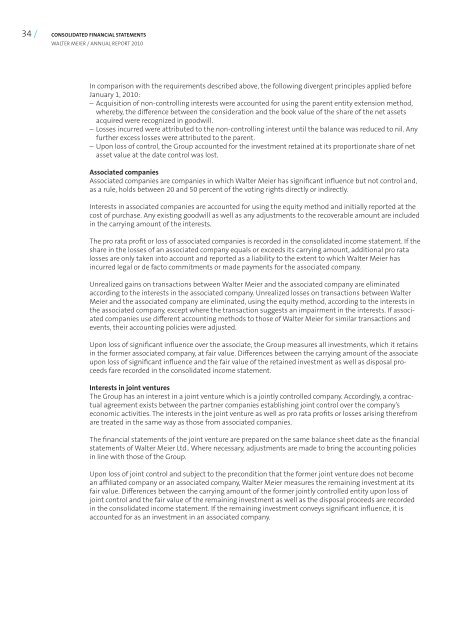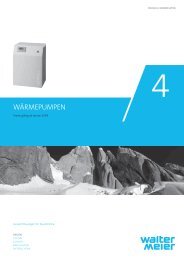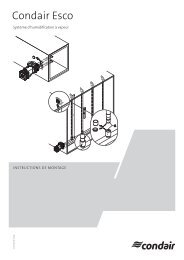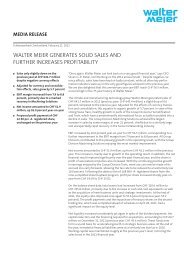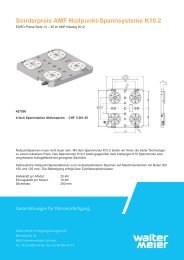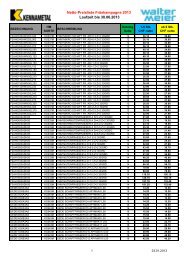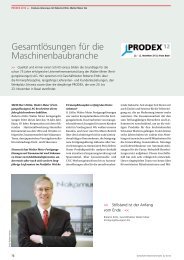AnnuAl report 2010 - Walter Meier
AnnuAl report 2010 - Walter Meier
AnnuAl report 2010 - Walter Meier
You also want an ePaper? Increase the reach of your titles
YUMPU automatically turns print PDFs into web optimized ePapers that Google loves.
34 / Consolidated FinanCial statements<br />
<strong>Walter</strong> <strong>Meier</strong> / annual <strong>report</strong> <strong>2010</strong><br />
in comparison with the requirements described above, the following divergent principles applied before<br />
January 1, <strong>2010</strong>:<br />
– acquisition of non-controlling interests were accounted for using the parent entity extension method,<br />
whereby, the difference between the consideration and the book value of the share of the net assets<br />
acquired were recognized in goodwill.<br />
– losses incurred were attributed to the non-controlling interest until the balance was reduced to nil. any<br />
further excess losses were attributed to the parent.<br />
– upon loss of control, the Group accounted for the investment retained at its proportionate share of net<br />
asset value at the date control was lost.<br />
associated companies<br />
associated companies are companies in which <strong>Walter</strong> <strong>Meier</strong> has significant influence but not control and,<br />
as a rule, holds between 20 and 50 percent of the voting rights directly or indirectly.<br />
interests in associated companies are accounted for using the equity method and initially <strong>report</strong>ed at the<br />
cost of purchase. any existing goodwill as well as any adjustments to the recoverable amount are included<br />
in the carrying amount of the interests.<br />
the pro rata profit or loss of associated companies is recorded in the consolidated income statement. if the<br />
share in the losses of an associated company equals or exceeds its carrying amount, additional pro rata<br />
losses are only taken into account and <strong>report</strong>ed as a liability to the extent to which <strong>Walter</strong> <strong>Meier</strong> has<br />
incurred legal or de facto commitments or made payments for the associated company.<br />
unrealized gains on transactions between <strong>Walter</strong> <strong>Meier</strong> and the associated company are eliminated<br />
according to the interests in the associated company. unrealized losses on transactions between <strong>Walter</strong><br />
<strong>Meier</strong> and the associated company are eliminated, using the equity method, according to the interests in<br />
the associated company, except where the transaction suggests an impairment in the interests. if associated<br />
companies use different accounting methods to those of <strong>Walter</strong> <strong>Meier</strong> for similar transactions and<br />
events, their accounting policies were adjusted.<br />
upon loss of significant influence over the associate, the Group measures all investments, which it retains<br />
in the former associated company, at fair value. Differences between the carrying amount of the associate<br />
upon loss of significant influence and the fair value of the retained investment as well as disposal proceeds<br />
fare recorded in the consolidated income statement.<br />
interests in joint ventures<br />
the Group has an interest in a joint venture which is a jointly controlled company. accordingly, a contractual<br />
agreement exists between the partner companies establishing joint control over the company’s<br />
economic activities. the interests in the joint venture as well as pro rata profits or losses arising therefrom<br />
are treated in the same way as those from associated companies.<br />
the financial statements of the joint venture are prepared on the same balance sheet date as the financial<br />
statements of <strong>Walter</strong> <strong>Meier</strong> ltd.. Where necessary, adjustments are made to bring the accounting policies<br />
in line with those of the Group.<br />
upon loss of joint control and subject to the precondition that the former joint venture does not become<br />
an affiliated company or an associated company, <strong>Walter</strong> <strong>Meier</strong> measures the remaining investment at its<br />
fair value. Differences between the carrying amount of the former jointly controlled entity upon loss of<br />
joint control and the fair value of the remaining investment as well as the disposal proceeds are recorded<br />
in the consolidated income statement. if the remaining investment conveys significant influence, it is<br />
accounted for as an investment in an associated company.


